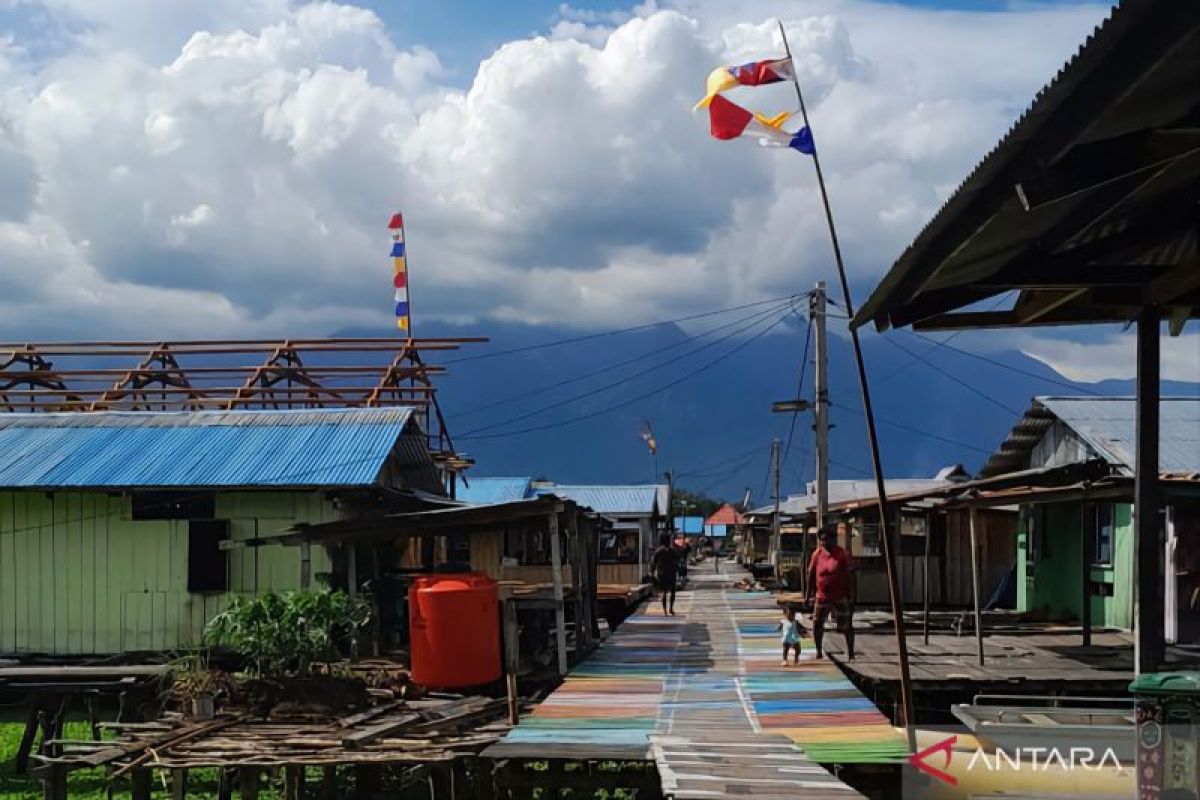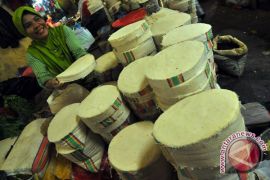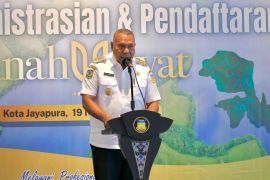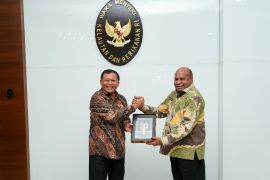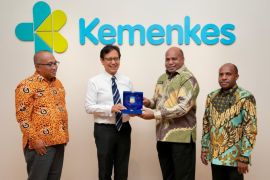The village is well-known on account of its unique setting: as it sits on Lake Sentani, it does not have any land area, unlike other villages. In addition, almost all homes in the village float on the lake, connected by a network of wooden bridges.
In recent years, Yoboi, which lies close to Papua New Guinea (PNG), has come to be known as a colorful village since almost all the bridges, houses, and public and private facilities in the village are painted in a patchwork of colors.
Given its uniqueness, Yoboi was registered as a tourist village by the Ministry of Tourism and Creative Economy through Pesona Indonesia in 2021, following the visit of Tourism and Creative Economy Minister Sandiaga Salahuddin Uno to the area.
The village has since received several national awards, including the 2022 Indonesian Tourism Village Award (ADWI).
Visitors to Yoboi Village are treated to the sight of buildings that still reflect local wisdom and values. Houses in the village are still made of wood and built on water.
Tourists coming to the village can carry out activities on the water through boards that serve as both bridges and roads.
The lush green sago forests that surround the village are also a feast for the eyes.
For the local people, sago is a staple food that has been passed down from the ancestors of the Sentani tribe or coastal Papuans.
Sago has been the staple diet of the inhabitants of Kampung Yoboi and the Sentani community since ancient times.
So far, the extraction of sago powder, especially in Yoboi Village, has involved a traditional technique called ‘tokok’ and the use of traditional tools.
Now, the residents of the village are set to receive a large number of sago processing tools from the representative of the Food and Agriculture Organization of the United Nations (FAO-UN) for Indonesia given the abundance of sago trees in the area.
The assistance program is expected to improve the micro, small, and medium enterprises (MSMEs) in Yoboi Village and serve as a pilot for modern sago processing in Indonesia.
FAO-UN survey
Following a series of surveys, FAO-UN conducted a direct survey in Yoboi Village, accompanied by the ranks of the Jayapura Regency Plantation and Animal Husbandry Office, to see how the residents make sago flour.
After the surveys, FAO-UN held workshops and public discussions with environmentalists, traditional leaders, community leaders, and MSME actors to directly gather their opinions about the plan for providing assistance for sago processing equipment.
All the participants expressed their gratitude for the assistance.
Further, FAO-UN wants Kampung Yoboi to set an example in large-scale processing of sago sustainably. The sago flour produced in the village under the assistance program would not only be used for daily needs, but would also be marketed.
The FAO-UN representative for Indonesia-East Leste, Rajendra Arya, said that he will help MSME actors in Yoboi Village manage the processing of sago in large quantities.
The sago processing equipment provided by the agency would be used to produce a large volume of sago flour and could be used to increase MSME activities and support sago export to areas outside Papua and even abroad.
Sago flour would be packaged in attractive packaging and sent to Papua Mountains, Central Papua, South Papua, and South West Papua, where it would be sold in supermarkets.
The step is a breakthrough to develop sago processing into a large industry so that sago products can be enjoyed not only by the Papuan people, but also by people living outside Papua.
The people of Yoboi Village would process sago flour into a variety of foods and drinks with high economic value and a fairly low sugar content value.
FAO-UN's support for efforts to develop the local sago industry is believed to stimulate the economic growth of the Papuan community.
The government of Jayapura District is enthusiastic about the FAO-UN's support for sustainable sago management.
"This is very good, in order to change the mindset of the community to process sago, not only limited to making papeda or sago porridge, but can be developed into processed with high economic value," acting head of Jayapura Regency's Plantation and Animal Husbandry Office, Jenny S. Deda, said.
Sago Hamletor
In the period from 1960 to 2000, Sago Hamletor or sago forest in Jayapura Regency covered a wide swathe of land. However, it is now starting to shrink due to a change in the function of some of the land into residential areas, among others.
In 2019, Bappeda pegged the estimated area under sago forests in Jayapura District at 3,302 hectares. The sago forests cover six subdistricts: Sentani 1,964.5 hectares; East Sentani, 473.0 hectares; West Sentani, 74.6 hectares; Waibhu, 138.9 hectares; Unus Guay, 277.3 hectares; and Demta, 374.6 hectares.
The local government is now trying to keep the sago forests from shrinking by changing the community's perspective to ensure that sago groves or forests continue to be well-preserved.
Sago is not only a source of food, but can be used to make a variety of food preparations, which can improve the family economy. The people of Papua used to consume papeda or sago porridge, and various types of tubers as staple foods. However, in the 1980s, they started to turn to rice-based foods.
Papuan customary figure Ramses Wally expressed strong support for FAO-UN's endeavor to help the people of Kampung Yoboi process sago sustainably improve community welfare.
"Sago is our identity in Papuan society because sago means we exist. Sago is so old with the customs and culture of the Papuan people," he remarked.
Sago, when managed properly and developed through technology, would help improve the welfare of the community since it can not only be used to make papeda, but also sold in the market in the form of clean and quality sago flour.
"Our duty as indigenous Papuans and as customary leaders must protect and convey to the people to return and maintain sago groves, not to be sold for a moment's pleasure, but (to be preserved so as not) to make grandchildren suffer for life," Wally added.To maintain sago land, the community must strive to preserve forests overgrown with various plants as the main food source of the people in Papua. In addition, forests where animals reside can also serve as a source of protein.
Related news: Introducing sago worldwide through Qatar-Indonesia Year of Culture
Related news: Qatari chef visits Papua to observe sago making
Editor: Rahmad Nasution
Copyright © ANTARA 2024
